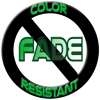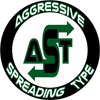Green Friendly™ Seed
Our Green Friendly™ line of turf seed helps maximize environmentally friendly requirements. With extensive on-going research and technology Ampac is able to offer:


CFR (Color Fade Resistant),
DT (Drought Tolerance)
SLT (Salt Tolerant)
AST (Aggressive Spreading Type)
Improved Disease Resistance
Varieties that are part of our Green Friendly™ lineup are:
Amazing A+ Perennial Ryegrass
Green Supreme Perennial Ryegrass
Amazing GS Perennial
Sidewinder Tall Fescue
Cochise III Tall Fescue
Cochise IV Tall Fescue
Ares Tall Fescue
Gibraltar Creeping Red Fescue
Rushmore Chewings Fescue
Gibraltar GOLD Creeping Red Fescue
Descriptions

Must demonstrate color retention at minimum 25% green cover at 25 days when irrigation is withheld. These varieties stay green longer and green back up faster.
Gibraltar Creeping Red FescueRushmore Chewings Fescue
Gibraltar GOLD Creeping Red Fescue

Must demonstrate ability to resist wilting and show minimum 25% ground cover at 25 days when irrigation is withheld. Now you can use less water.
Gibraltar Creeping Red FescueRushmore Chewings Fescue
Gibraltar GOLD Creeping Red Fescue
Green Supreme Perennial Ryegrass
Amazing A+ Perennial Ryegrass
Sidewinder Tall Fescue
Cochise IV Tall Fescue
Ares Tall Fescue
NOTE: CFR and Drought Tolerance are interrelated. The more days of green cover (varieties that are last to go dormant due to lack of moisture) result in a faster green up when moisture is applied. This is due to those varieties being under stress for a much smaller period of time.

Must demonstrate high survival rates when subjected to high levels of total soluble salts (ECe = 6.0 - 9.0 mS/cm) in studies at University and other accredited Private Research Facilities. These varieties are great for roadsides or near sidewalks where ice melt is used or in turf settings where high salinity is a problem.
Sidewinder Tall FescueGreen Supreme Perennial Ryegrass
Amazing A+ Perennial Ryegrass

The next generation of improved spreading type tall fescues is available. Cochise IV Turf Type Tall Fescue is not only top of its class in the 2006 NTEP. (#1 on Schedule A and shows a 6.1 out of 6.4 rating on Schedule B), it was bred for aggressive tillering at Rutgers University. This characteristic contributes to its natural self repairing capabilities, high traffic tolerance, and its dense turf quality. Sidewinder Turf Type Tall Fescue, new this fall, is an aggressive spreading type via rhizomes. Expedition Turf Type Tall Fescue also falls into the aggressive spreading type and is Ampac's original spreading tall fescue. (Tillers = Shoots that come from the crown of the plant. Rhizomes = Underground lateral shoots that produce new plants.)
Cochise IV Tall FescueSidewinder Tall Fescue
Ares Tall Fescue

Gray leaf spot, or blast, is caused by the fungal pathogen Pyricularia grisea, a disease affecting perennial ryegrass in several regions of the United States. Research has produced new varieties of Perennial Ryegrass that are resistant to this disease. This means less chemicals used; not only better for the environment but also less expensive. Amazing GS (7.5 mean*) and Phenom (8.5 mean*) Perennial Ryegrass both are top NTEP varieties that offer Gray Leaf Spot Resistance. *(2005 NTEP Data, 9=no disease, 1.1 LSD)
Green Supreme Perennial RyegrassAmazing A+ Perennial Amazing GS Perennial

Brown patch, Rhizoctonia solani, is a disease of hot, humid weather. It is most common when night temperatures and relative humidity stay high for several days and are accompanied by rain. Disease development can be very rapid under such conditions. This means less chemicals used; not only better for the environment but also less expensive to maintain.
Cochise IV Tall FescueCochise III Tall Fescue
Gibraltar Creeping Red Fescue
Sidewinder Tall Fescue
Summary
Our goal is for you to immediately be able to identify the logo and the stand-out characteristics associated with it at a glance. Thus, helping you pick the correct variety for your turf application.
Ampac will continue to develop and research new varieties and categories to add to this line up.
